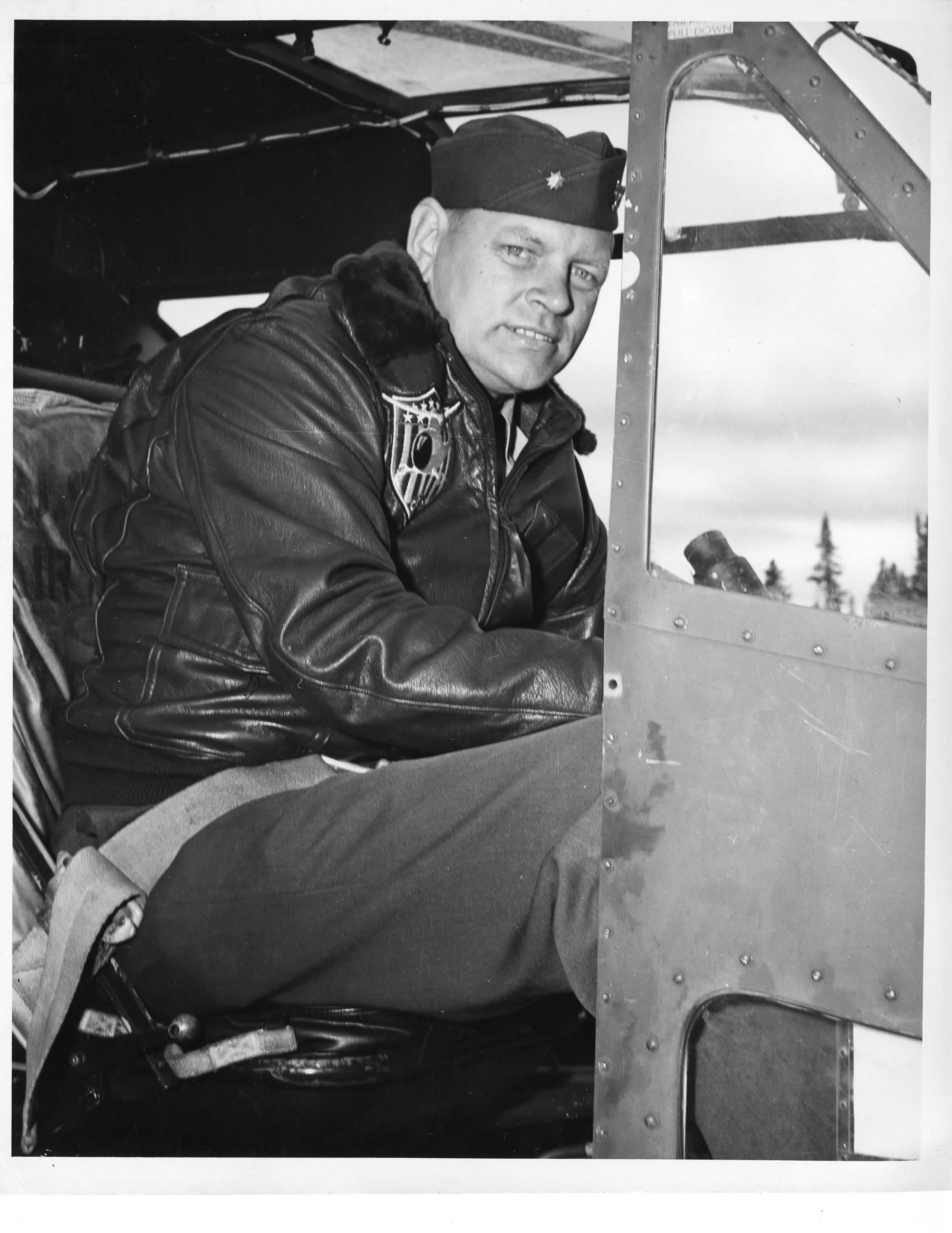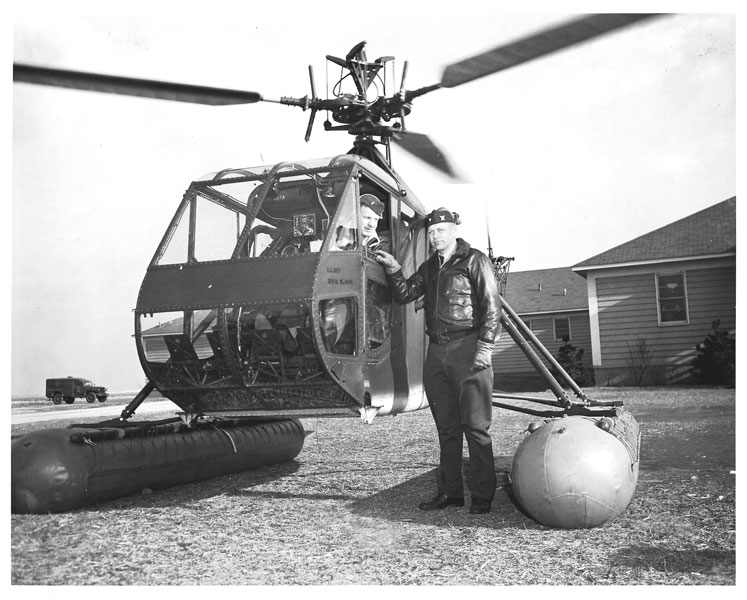Just over 80 years ago, LCDR Frank A. Erickson flew the first helicopter rescue mission in history, ushering in a new era in search and rescue techniques.
Born in Portland, Oregon, Erickson served in the Navy before enlisting in the United States Coast Guard. He received an appointment to the Coast Guard Academy and was commissioned in 1931. While at the Academy, Erickson developed a passionate interest in the techniques of search and rescue and, on May 14, 1935, became Coast Guard Aviator #32.
In August 1941, Erickson was serving on board the cutter Taney in the port of Honolulu and then on Ford Island, Pearl Harbor, as the Assistant Operations Officer. While there, he read an article in Aero Digest Magazine describing a small helicopter built by the Sikorsky Aircraft Corporation. To Erickson, it was unquestionably the ideal tool for Coast Guard aviation—a tool that would greatly improve aerial search and rescue capabilities.
On December 7, 1941, Erickson witnessed the Japanese attack on Pearl Harbor. From the airplane control tower, he saw Hickam Field erupt in flames. To the north, smoke billowed up from Wheeler Field as it did from Eva Mooring Mast Field to the west. He watched wounded and oil-covered men crawling onto the shoreline of Ford Island while others struggled in the water. There was no way to recover those men quickly. Erickson became convinced a helicopter could have saved many lives.

Five months later, in April 1942, Erickson’s longtime friend, LCDR William Kossler, Chief of the Coast Guard’s Aviation Engineering Division, witnessed a helicopter demonstration at Vought-Sikorsky aircraft plant. He immediately wrote to Erickson, stating, “What a magnificent demonstration! This has to be the answer to the Coast Guard rescue problem!”
In June, Erickson had the opportunity to travel to the Sikorsky plant. Calling it “a day I shall never forget,” Erickson was captivated. Spurred-on by what he had witnessed, he wrote to Admiral Russell Waesche, Commandant of the Coast Guard, outlining possible future missions for the helicopter. While he fervently believed in its potential as a search and rescue platform, Erickson was also aware of the opposition to the helicopter by both Navy and Coast Guard leadership. While he noted the law-enforcement and rescue capabilities of the helicopter, he also introduced the potential capacity for “providing aerial protection for convoys against submarine action.”
Erickson was often described as a zealot. According to Kossler, he was “always the salesman, willing to explain the helicopter’s merits to anyone who would listen. His visions of the helicopter’s future seemed highly extravagant to the fixed-wing clan, and his predictions were often ridiculed behind his back.” Together, Erickson and Kossler became an unshakable team, both passionate about the helicopter’s future.
In February 1943, Kossler was directed to create a helicopter training program. Erickson was selected to be first Coast Guard aviator to qualify as a helicopter pilot. Flying a modified XR-4A, a “rather unstable machine,” Erickson caught on quickly and soloed on June 16th with less than three hours of total flight time.

Over the next several months, testing continued on helicopters as an anti-submarine platform. On January 3, 1944, the helicopter finally took on a rescue role. The destroyer USS Turner, anchored near Ambrose Light in Lower New York Bay, suffered an explosion in the early morning hours. A second explosion occurred 47 minutes later, sinking the destroyer. Survivors were brought to a hospital in Sandy Hook, New Jersey. Plasma was badly needed, but a nor’easter raged, and all fixed-wing aircraft were grounded. Timely ground delivery was all but impossible.
According to the day’s Flight Operations Report, “Rear Admiral Stanley Parker called at 10;00 3 January and inquired as to the practicability of sending a helicopter to the Barge Office for the purpose of flying blood plasma to Sandy Hook for the victims of the USS Turner disaster.” Despite the fact that he had not flown in such conditions, Erickson’s response was immediate. Such a flight could prove that the helicopter was the future of Coast Guard rescue capabilities. Clearance had to be obtained from the Commander New York Air Patrol as Floyd Bennett Field was closed due to the weather. Finally, at 10:20 a.m., HNS-1 helicopter CG-46445, with Erickson at the controls and co-piloted by ENS Walter Bolton, lifted off in swirling snow and gusty winds.
The flight to Battery Park was characterized by extremely low visibility, and strong winds. Erickson later stated, “We practically had to ‘feel’ our way around the ships in Gravesend Bay.” Bolton stayed behind after plasma was loaded into the helicopter. Blocked by trees to the front, the only way to get out was to back out. Battered by winds, Erickson deftly coaxed the helicopter into flight. At approximately 10:55 a.m., the HNS-1 finally rose vertically, flew to Sandy Hook Coast Guard Station and landed at 11:09 a.m.
.jpg?ver=_VpF-IAqcXKRYE_i4NLWHQ%3d%3d)
Erickson simply stated, “Weather conditions were such that this flight could not have been made by any other type of aircraft,” adding that the flight was “routine for the helicopter.” The New York Times lauded the historic flight stating:
"It was indeed routine for the strange rotary-winded machine which Igor Sikorsky has brought to practical flight, but it shows in striking fashion how the helicopter can make use of tiny landing areas in conditions of visibility which make other types of flying impossible. . .. Nothing can dim the future of a machine which can take in its stride weather conditions such as those which prevailed in New York on Monday."
LCDR Kossler wrote a recommendation that Erickson receive a Distinguished Flying Cross for the January 1944 rescue mission, but no action was ever taken. Perhaps the greatest monument to Frank Erickson is the number of those rescued by helicopters over the years since this first helicopter mission in 1943. Among those, were 12,535 air rescues in a period of two weeks during Hurricane Katrina. During the unprecedented hurricane season of 2017, 11,363 lives were saved by helicopters. This is a testimony to Erickson’s vision, passion, and unshakeable belief in the capabilities of the helicopter.
-USCG-